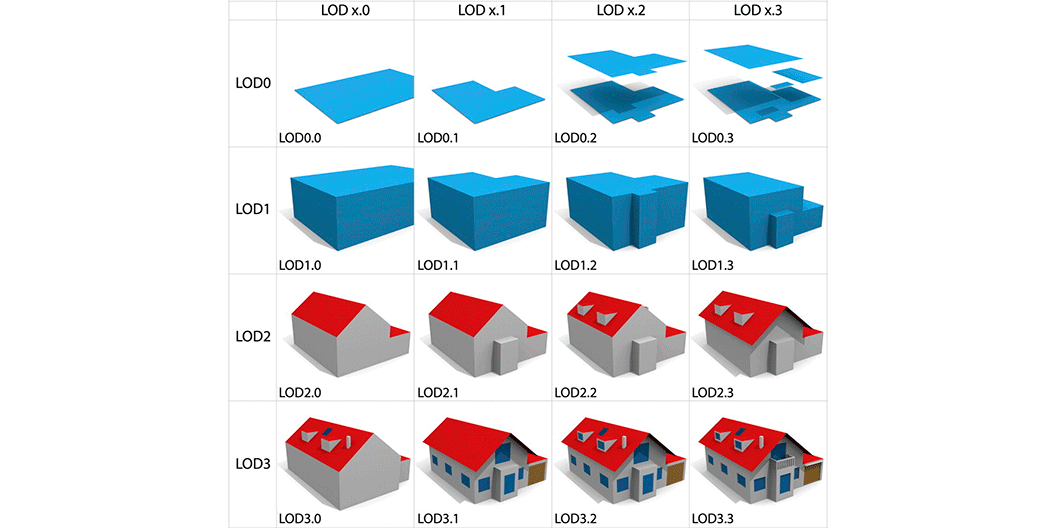Among the various requirements and details needed—following the IDS and BEP—there is the LOD, an acronym for “Level of Definition” in the UK architectural model from PAS 1192, or “Level of Development” of an element in a BIM model, considering the American model. This variation in terms arises because the American model prefers the concept of “level of development” over “level of detail,” as a graphically detailed element does not always correspond to a high level of actual project development.
Structure of LOD
LOD is structured hierarchically in levels, each with its standard nomenclature depending on the reference standard. The more advanced the development phase, the higher the level (i.e., the level of detail).
LOD also comprises two elements:
- LOG (Level of Geometry): the geometric part
- LOI (Level of Information): the data attached to geometric objects
LOD in the United States
The AIA (American Institute of Architects), through the AIA G202-2013 Building Information Modeling Protocol, aimed to standardize the various development phases (and thus levels) for each project element. This facilitates communication and exchange among the various stakeholders in the BIM project. The different LODs in the American standard are:
- LOD 100 (symbolic representation): the basic model element is represented with a symbol or another generic representation.
- LOD 200 (generic system): at this level, the basic element has quantity, size, shape, positioning, and orientation, but still approximately. It’s possible to link information to graphic elements.
- LOD 300 (specific system): the properties of the previous level are more specific, and each element has more in-depth non-graphic information.
- LOD 400 (fabrication): dimensions, shape, position, quantity, and orientation of the element are more detailed than in previous levels, and additional information on realization, assembly, and installation is associated. The linked non-graphic data are more detailed.
- LOD 500 (verified representation – as built): dimension, orientation, position, and quantity are verified on-site; the non-graphic information is even more detailed.
LOD in the United Kingdom
Similarly to the United States, in the United Kingdom, the Construction Industry Council (CIC) in 2013 published the CIC BIM protocol for the first time, defining responsibilities, limits, and outcomes of BIM project members for each level of detail. The phases, like the American ones, are divided into:
- LOD 1 (brief): elementary detail level, hypothesizing the block model with performance requirements and site constraints.
- LOD 2 (concept): information such as basic areas and volumes, orientation, and cost are inserted.
- LOD 3 (developed design): further information such as approximate quantity, size, shape, position, and orientation.
- LOD 4 (production): the model reaches technical design details; the elements are accurate enough to estimate costs and regulatory constraints.
- LOD 5 (installation): the model’s accuracy is such that it is suitable for construction and assembly.
- LOD 6 (as constructed): the level of detail is such that it can be used post-construction for the management and maintenance of the asset.
- LOD 7 (in use): the model is used for the operation and maintenance of the building.
In Italy
With the standard UNI 11337, various levels of detail were introduced in Italy as well. Unlike the Anglo-Saxon approach, these levels are labeled with letters of the alphabet (A, B, C, etc.):
- A (symbolic object): No geometry is provided; each element is represented symbolically.
- B (generic object): Entities have generic and approximate geometry.
- C (defined object): The geometry is defined; quantitative and qualitative information is generic but compliant with minimum regulatory standards.
- D (detailed object): Geometry and both qualitative and quantitative definitions are specific. Additional information is introduced to allow the calculation of the object’s space requirements and any interference with other entities.
- E (specific object): This level includes details related to manufacturing, assembly, installation, and maneuvering space.
- F (executed object): The object is verified on-site; all characteristics refer to the installed element. This level enables planning for management, maintenance, repair, and/or replacement throughout the asset’s life cycle.
- G (updated object): Entities are updated to reflect their actual condition at a given point in time. All details are such that they allow the planning of interventions (management, maintenance, repair, and/or replacement) for the entire life cycle of the work.
From LOD to LOIN
With the introduction of the Level of Detail (or Development), professionals—concerned about insufficient detail—tend to overload the model with information, resulting in too much data. To address this, ISO 19650-1 introduces the concept of LOIN: Level of Information Need, which goes beyond the traditional concept of LOD.
But what is LOIN? With LOIN, the focus shifts away from the characteristics of the object itself and instead considers what information the model should contain, based on specific conditions. In practice, the level of detail required should be evaluated according to certain criteria or questions, such as: which professionals are involved with a particular object, what is its purpose, what is its structure or format, does it have a deadline or expiration. Based on these criteria, it becomes possible to define the necessary level of detail for that specific object—only what is truly needed.
Viewing BIM models in GeoDropBox
When uploading any type of document, if you upload a BIM file with an IFC extension, you can view the 3D model directly online. But not only BIM, through the viewer you will be able to view images, pdf and text files.













